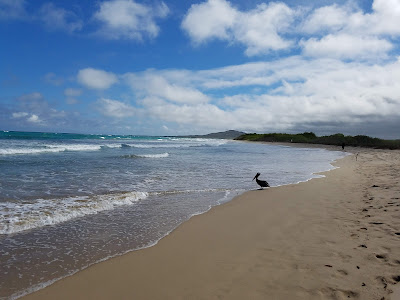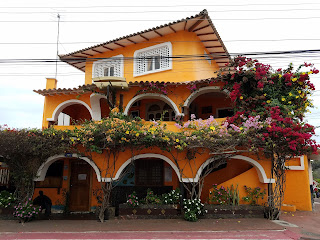I booked and paid for my cruise in cash at Galapagos Mockingbird Travel Agency in Puerto Ayora, Santa Cruz less than two days prior to embarkation. As mentioned in my previous post, the Millennium was the only boat that met my requirements regarding the itinerary and a schedule that would fit my travel dates. Since I had already spent one week on San Cristobal island (including taking two day trips to other islands and places I could not visit on my own) plus five days on Santa Cruz, I was not interested in repeating any of those experiences during the cruise. The Millennium's northern and western islands itinerary was almost exactly what I would have designed myself if I was chartering a boat.
 |
| A screenshot from a travel agency's website showing the typical northern and western Galapagos Islands cruise itinerary. |
 |
| A stock photo of the Millennium. |
 |
| Stateroom #4 on the Millennium. |
 |
| The dining room set up for dinner on Day 1 of the cruise. |
 |
| My cruisemates and our captain (lower right) on Day 4 of the cruise. |
 |
| Whitman and I at the Centro de Crianza de Tortugas Terrestres (Land Tortoise Breeding Center) on Isabela island. |
 |
| The crew gathers in the common area for a welcome toast. |
I feel like I hit the jackpot regarding my cruisemates for the first five days. I say this not only because they were all super friendly and enthusiastic about the cruise and about making the most of our experience, but also because everyone was very conscious of how their actions affected the others. No one hogged the photo ops, or was constantly late or lagging behind, or interrupting the guide, or taking too much food on the first pass at the buffet, or always talking about politics, or whining when the weather wasn't perfect or when we didn't get to see or do something as planned.
I actually have something to compare to because the entire group, with the exception of myself and two other North Americans, disembarked on the morning of Day 6 and new passengers boarded later that afternoon. The new group was completely different! The average age was now mid-50's to 60's and there was also a family with three children (approximate ages 8, 10 and 12). While everyone was still very friendly, the vibe was much more low key. About half of them were not in great physical shape (i.e. they were overweight) and they skipped some of the excursions. The kids, while generally well-behaved, had a tendency to scream or shout especially when snorkeling. Several of the passengers were carrying expensive photographic equipment and often fell behind the group during our hikes because they were taking so many photos. You get the idea.
Now, without further delay, here are my daily notes from the cruise.
Day 1: Wednesday, July 17 - Santa Cruz highlands
I met my fellow cruisers for the first time this afternoon at Rancho El Manzanillo where you can walk among the free-range land tortoises. About half of the group came directly from the airport; others had already been on the islands for a few days and thus had taken a taxi from Puerto Ayora. Whitman led us on a tour for about an hour and then we ate a late lunch at the onsite restaurant. We bused back to the port and took our first dinghy ride to the Millennium at 6 p.m. We received our cabin assignments and had time to unpack before dinner. We set sail shortly after we ate which forced everyone to go to their staterooms as the boat was rocking violently and most of us felt motion sick. While I never got physically ill, it was the first of many times that week where the only thing I could do was lie in bed; it felt like being in a washing machine on agitate cycle!
 |
| Our group observing a land tortoise at Rancho El Manzanillo. |
The original itinerary included a trip inland to hike Volcan Sierra Negra but, because it was overcast and we wouldn't have been able to see much, we opted to stay closer to the water. We ate breakfast at 6:15 and boarded the dinghies at 7:00. First we landed at Islote Tintoreras and hiked around the lava for 1.5 hours. We saw tons of wildlife including our first sharks and penguins. Then we took the dinghies to Puerto Villamil and transferred to a van for the trip to the Land Tortoise Breeding Center. We spent an hour there observing the tortoises (saw one pair mating!) and then followed a trail/boardwalk through a saltwater lagoon (flamingos!) to the beach. We watched some marine iguanas swimming and climbing around the lava rocks, then transferred back to the dock and took the dinghies back to the boat for lunch.
 |
| White-tipped reef sharks rest in the Tintoreras Grotto. |
 |
| I mostly had the beach to myself on my long walk to the cemetery. |
We ate breakfast at 7 a.m. then took the dinghies to shore for a two hour hike around the lava fields. We passed several lagoons (more flamingos!) and saw lots of interesting lava formations and cacti. Then we reboarded the dinghies for a ride around the shoreline where we saw our first flightless cormorants, some penguins, and lots of marine iguanas. We returned to the boat for lunch and then set sail for Fernandina around 1 p.m.
 |
| The Millennium at anchor off of uninhabited Fernandina island. |
We ate breakfast at 6:15 and by 7 a.m. we were in the dinghies heading for shore. We spent two hours hiking around the lava formations and a small lagoon where we observed rays feeding. We also saw a large marine iguana colony, flightless cormorants nesting and our first snake, plus I spotted a whale spouting in distance. Then we went deep water snorkeling (tons of sea turtles and marine iguanas feeding underwater) before sailing across to Tagus Cove.
 |
| A selfie at Darwin Lake, formed in a volcano crater. |
 |
| Can you see the equator? ;) |
Per routine, we ate breakfast at 6:15 and were on the beach just after 7 a.m. We hiked for almost two hours and saw tons of birds feeding, a few sharks, plus our first fur seals (they are actually another species of sea lion) and our first land iguana. Then we had one hour for optional snorkeling or beach time. I chose to hike alone around the shoreline and then up to an old house (there was once a salt mine here) and viewpoint. I also found an adorable baby sea lion that was less than one week old. We returned to the boat and set sail for Sombrero Chino.
 |
| A quiet morning on Egas Beach. |
 |
| See the baby sea lion? It blends in so well with the rocks! |
This morning we went for a dingy ride in Black Turtle Cove at 6:30 a.m. We saw sharks, rays, lots of birds, and turtle tracks from where they nest on the beach. We ate breakfast at 8 a.m. and then everyone disembarked at 9 a.m. except myself, Debby and Jack.
 |
| One last dinghy excursion with my original cruisemates. Here we are looking at blue-footed boobies. |
 |
| Returning to the boat after a dinghy excursion. |
 |
| Those puffy white balls are baby frigates. They have black wings. |
We ate breakfast at 6:45 and then took the dinghies ashore. We hiked to the summit of East Bartolome where there is a 360 degree view of the beautiful and diverse island landscape that epitomizes the Galapagos. Just under two hours later we were back in the dinghies for a ride around Pinnacle Rock where we spotted a lone penguin. Back on the boat, we changed into our wetsuits and went snorkeling on the beach near Pinnacle Rock. We ate lunch on the boat at 11:30 then sailed the short distance to Sullivan Bay.
 |
| Notice all of the boats in the background. Bartolome and Sullivan Bay are on most cruise itineraries and are also popular day trips out of Puerto Ayora. |
 |
| I love the contrast of the lava, the dried salt, and the ocean at Sullivan Bay. |
There was a bit of chaos this morning because the crew, particularly Whitman, didn't realize I was booked on the first flight out of Baltra at 10 a.m. We took the dinghies to the beach at 6:15 a.m. and walked around on the sand for an hour. We were hoping to see flamingos in the lagoon but only saw a few other birds and a couple of iguanas sleeping in the mud. Back on the boat we ate breakfast
and Jack, Debby, and I disembarked on Baltra at 8:30 a.m. We took the shuttle bus to the airport and my flight left on time at 10 a.m.
 |
| My last Galapagos sunrise in July. |
Summary
With the exception of the crazy, somewhat stressful process and effort required to book this cruise at the last minute plus some wasted time and lack of organization on Day 1 and especially on Day 6, my entire Galapagos cruise experience was fantastic. The wildlife and scenery were amazing. Most of the time we were the only visitors on the uninhabited islands. The boat, while not perfect, was clean and comfortable. The food, snacks, and drinks were delicious. The crew and my fellow passengers were awesome. In the end, while of course I would have liked to spend less, I think it was worth $2,000 for the week. But I'm not sure I could say the same if I had paid the regular $4,000+ rate.If anyone asks me for recommendations for visiting the Galapagos, I would generally tell them to do something similar to what I did: Fly into San Cristobal and spend a week or so sightseeing independently with a couple of excursions (to Espanola and maybe a 360 tour) and then ferry to Santa Cruz and spend a couple of days sightseeing on your own there. Then do a full week cruise to the northern/western islands (same itinerary as mine).
One final note about cruising and the Galapagos in general. While I did have wifi access at my accommodations in San Cristobal and Santa Cruz, it was very slow. I didn't have wifi or cellular service for the entire week on the boat. I had to wait until I was back on the mainland to upload all of my photos and videos. Thus it is a good idea to have a way to back up your photos daily to another drive or device in case something happens to your cell phone or camera during the trip.
You can read my abbreviated daily summaries, which are split into two posts per day for morning and afternoon activities, by searching the keyword "Galapagos" on my Facebook,
Instagram, and YouTube accounts, or by scrolling to the posts that occurred between July 24 and August 8, 2019. There are also photos from my independent Galapagos adventures prior to the cruise that start on July 5.
This is a slideshow of some of my favorite photos from the cruise. Enjoy!





























